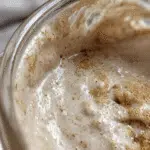Description
Avoid a moldy sourdough starter with proper care, storage, and inspection tips. This guide helps you recognize, prevent, and respond to mold confidently.
Ingredients
Clean glass jars
Filtered water
Unbleached flour
Dry cloth or loose lid
Clean spoon
Optional: dried sourdough starter backup
Instructions
Inspect your starter visually and smell for signs of spoilage.
If you see pink, orange, or fuzzy mold, discard the starter immediately.
Feed your starter using equal parts flour and water in a clean jar.
Use filtered water to avoid chlorine that harms the culture.
Store the starter with a loose lid or cloth in a cool, dry place.
Cool bread fully before wrapping in cloth or paper for storage.
Dry a small portion of starter on parchment as a backup.
Notes
Always err on the side of caution if mold appears.
A moldy sourdough starter should not be salvaged if it shows colored fuzz.
Clean tools and regular feeding are your best defense.
- Prep Time: 5
- Category: Sourdough
- Method: No-cook, Guide
- Cuisine: Global
Nutrition
- Serving Size: 1
- Calories: 0
- Sugar: 0g
- Sodium: 0mg
- Fat: 0g
- Saturated Fat: 0g
- Unsaturated Fat: 0g
- Trans Fat: 0g
- Carbohydrates: 0g
- Fiber: 0g
- Protein: 0g
- Cholesterol: 0mg
Keywords: moldy sourdough starter, sourdough mold prevention, sourdough care, discard sourdough
